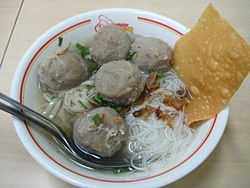Bakso
| Bakso | |
|---|---|
|
Bakso served with bihun (rice vermicelli) and fried wonton. | |
| Course | Main |
| Place of origin | Indonesia, derived from Chinese meat ball |
| Region or state | Nationwide in Indonesia, also popular in neighboring Southeast Asian countries |
| Creator | Indonesian Chinese |
| Serving temperature | Hot |
| Main ingredients | Ground beef, tapioca, noodle, rice vermicelli, beef broth, kailan, celery, salted vegetables, fried shallots |
| Variations | Bakwan Malang, Phở Bò Viên,(Vietnamese noodle soup with meatballs), Chinese beef balls |
|
| |

Bakso or baso is Indonesian meatball or meat paste made from beef surimi and is similar in texture to the Chinese beef ball, fish ball, or pork ball.[1] Bakso is commonly made from beef with a small quantity of tapioca flour, however bakso can also be made from other ingredients, such as chicken, fish, or shrimp. Bakso are usually served in a bowl of beef broth, with yellow noodles, bihun (rice vermicelli), salted vegetables, tofu, egg (wrapped within bakso), Chinese green cabbage, bean sprout, siomay or steamed meat dumpling, and crisp wonton, sprinkled with fried shallots and celery. Bakso can be found all across Indonesia; from the traveling cart street vendors to restaurants. Today various types of ready to cook bakso also available as frozen food commonly sold in supermarkets in Indonesia. Slices of bakso often used and mixed as compliments in mi goreng, nasi goreng, or cap cai recipes.
Unlike other meatball recipes, bakso has a consistent firm, dense, homogeneous texture due to the polymerization of myosin in the beef surimi.
Origin
The name Bakso originated from bak-so (肉酥, Pe̍h-ōe-jī: bah-so·), the Hokkien pronunciation for "shredded meat" (Rousong). This suggests that bakso has Indonesian Chinese cuisine origin.[2] Today most of the bakso vendors are Javanese from Wonogiri (a town near Solo) and Malang. Bakso Solo and Bakso Malang are the most popular variant; the name comes from the city it comes from, Solo in Central Java and Malang in East Java. In Malang, Bakso Bakar (roasted bakso) is also popular. As most Indonesians are Muslim, generally Bakso is made from beef or is mixed with chicken.
Variations
Similar meatball dishes can be found in other Southeast Asian cuisines, such as those in Thailand, Vietnam and Singapore, as well as Chinese-style meatballs. The dish also similar with Vietnamese noodle soup with meatballs, Phở Bò Viên.[3][4] In Vietnam, Phở means noodle soup while Bò Viên is meatballs.[5] Phở Bò Viên is one of version of Pho dish in Vietnam. It has been considered as the national dish of Vietnam.[6] In the Philippines, meatballs are called almondigas or bola-bola, and are usually served in a misua noodle soup with toasted garlic, squash and pork cracklings. Bola-bolas are also stewed or pan-fried until golden brown. Nevertheless, Indonesia has developed numbers bakso variants, usually differs by its shape and size, ingredients or fillings.
- Bakso urat: bakso filled with tendons and coarse meat
- Bakso ayam: chicken bakso
- Bakso bola tenis or bakso telur: tennis ball sized bakso with boiled chicken egg wrapped inside
- Bakso gepeng: flat bakso
- Bakso ikan: fish bakso (fish ball)
- Bakso udang: shrimp bakso with slightly pink color
- Bakso Malang: a bowl of bakso dish from Malang, East Java; complete with noodle, tofu, siomay and fried wonton
- Bakso keju: new recipe bakso filled with cheese
- Bakso kotak: cube-shaped bakso
- Bakso bakar: grilled skewered bakso prepared in similar fashion like satay
- Bakso Cuanki: a famous bakso in Bandung, West Java
Health issue
In Indonesia, borax is often added into beef surimi mixture in order to preserve the produced bakso, also to made bakso more chewy (from borax induced myosin cross-linking) with less usage of meat.[7] As a result, bakso is often listed by Indonesian Food and Drug Administration as an unhealthy foodstuff. The country's Directorate of Consumer Protection warns of the risk of liver cancer caused by high consumption over a period of 5–10 years.[8] Therefore, frozen bakso being sold at supermarkets and also traditional markets in Indonesia are required to be borax free.
See also
- Food portal
References
- ↑ "The soup Obama loved as a child". yahoo news.
- ↑ Alison Murray. No Money, No Honey: A study of street traders and prostitutes in Jakarta. Oxford University Press, 1992. p. Glossary page xi.
- ↑ "Pho Bo Recipe (Vietnamese Beef Rice Noodle Soup)".
- ↑ "Bakso: The ‘New’ Pho".
- ↑ "Bò Viên (Vietnamese Beef Meatballs)".
- ↑ "Pho: national dish, international obsession". Vietnews Online. February 14, 2010. Retrieved 2010-07-07.
- ↑ Boraks Ada dalam Makanan Kita, Suara Merdeka
- ↑ Staff writer (2006). "Watch Out For The Food We Consume". Directorate of Consumer Protection, Jakarta, Indonesia. Archived from the original on 28 December 2008. Retrieved 2009-02-10.
| Wikimedia Commons has media related to Bakso. |
